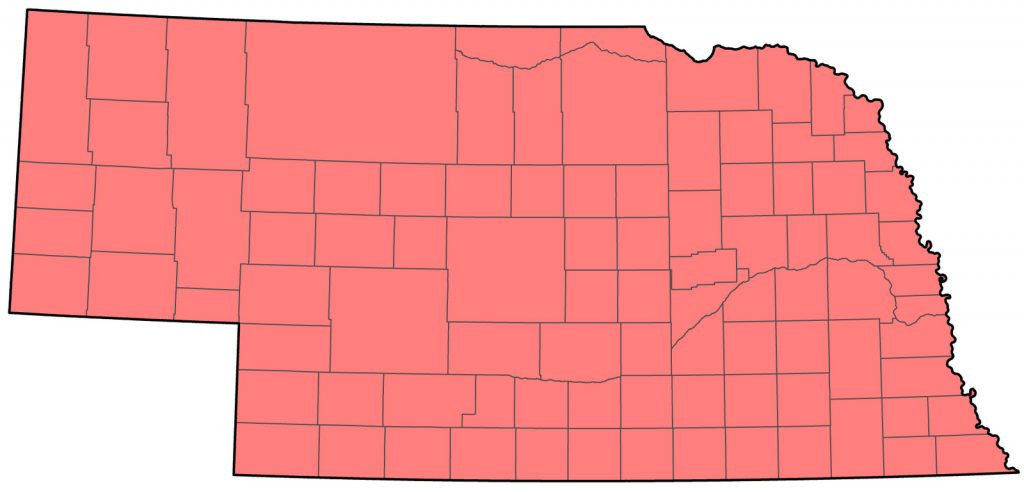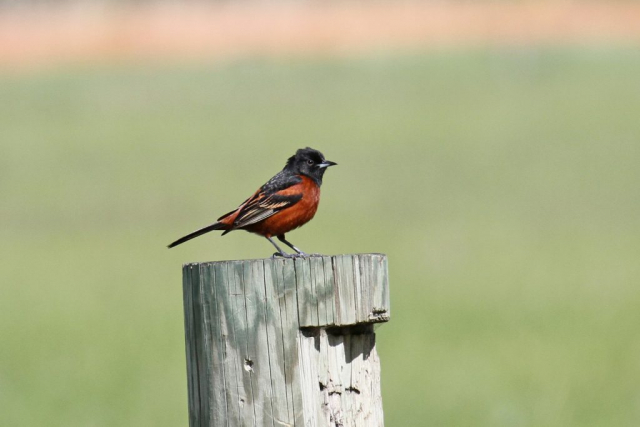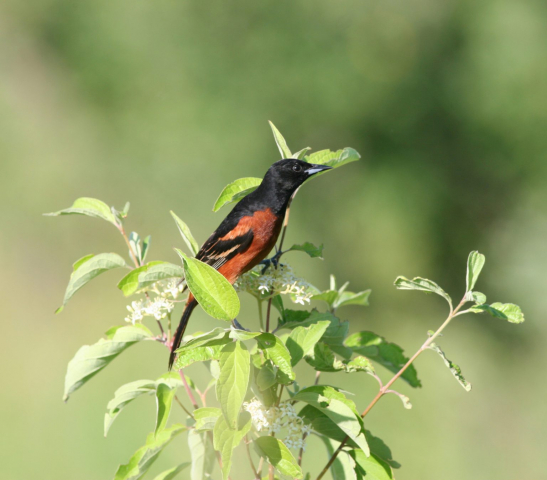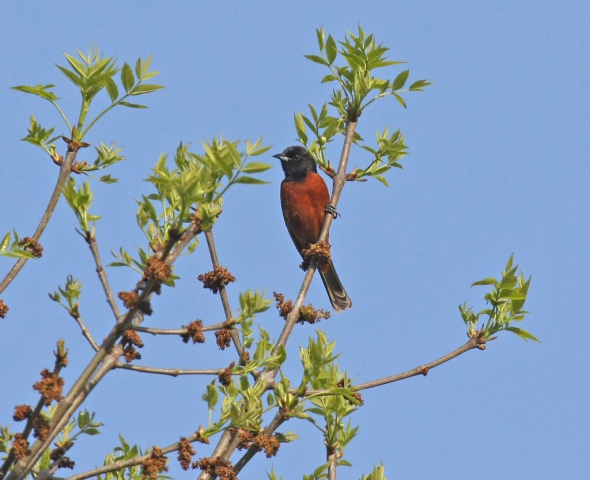Icterus spurius spurius
Status: Common regular spring and fall migrant and breeder statewide.

Documentation: Specimen: UNSM ZM8770, 14 Jun 1898 Lincoln, Lancaster Co.
Taxonomy: Two subspecies are recognized (AviList 2025), spurius, breeding throughout eastern US north to Canada and south to central Mexico, and fuertesi, breeding in eastern Mexico.
Nebraska birds are spurius.
Spring: Apr 26, 26, 26 <<<>>> summer
Earlier dates are 22 Apr 2008 Lancaster Co, 23 Apr 2025 Lancaster Co, and 24 Apr 2010 Lancaster Co.
A banding/recapture study in a Hall Co yard in 2014 and 2015 resulted in an estimated 37 individual birds present 11 Jun 2014, and 41 during 14 May-15 Jun 2015 (Lingle 2015). In the same yard, through 18 May 2023, a count of 39 Orchard Orioles and 112 Baltimore Orioles was made, with a final total estimate expected around 250 orioles (Gary Lingle, personal communication).
A study by Jorgensen and Brenner (2024) found that spring arrival dates had advanced by one day from 1938 to 2024.
- High counts: 136 at two locations in Dundy Co 26 May 2019, 96 at Rock Creek SRA, Dundy Co 2 Jun 2022, 92 there 17 May 2023, 75 there 14 May 2022, and 55 in the Keith Co area 18 May 1986 (Rosche 1994).
Summer: Mollhoff (2016) showed even and rather dense distribution statewide. BBS data 2011-2015 (Sauer et al 2017) show a similar uniform distribution. Nesting can be semi-colonial (Scharf and Kren 2022); as many as eight nests have been found in a single tree (Brown and Brown 2001).
This species has expanded its breeding range westward this century (Short 1961). Bruner et al (1904) stated that it was a “common breeder west to the 100th meridian [line from Keya Paha to Furnas Cos] or a little further.” Ducey (1988) cited no breeding records for the Panhandle prior to 1920, while Rapp et al (1958) considered it a common summer resident in the eastern two-thirds and especially the eastern quarter of Nebraska and added that its status in the west was “poorly known.” By 1980, Johnsgard (1980) noted that it was breeding “virtually statewide, less commonly in the extreme west.” BBS trend analysis (Sauer et al 2020) shows the species has increased 1.47% (95% C.I.: 0.61, 2.3) annually statewide during the period 1966-2019. These trends indicate that while the species has occurred statewide for some time, abundance has generally continued to increase.
- Breeding phenology:
Nest building: 5 May-25 Jun
Eggs: 16 May- 15 Jul (Mollhoff 2022)
Nestlings: 18 Jun- 18 Jul
Fledglings: 22 Jun-25 Aug
- High counts: 85 around Lake McConaughy, Keith Co 22 Jun 2002, 68 at Rock Creek SRA, Dundy Co 18 Jun 2025, and 50 Lake McConaughy 10 Jun 2007.
Fall: summer <<<>>> Sep 22, 22, 22
Orchard Orioles begin to flock in mid-Jul and leave the breeding grounds in Aug, with the last birds leaving the southeast by mid-Sep. A mixed age and sex flock of 12 was at Branched Oak Lake, Lancaster Co 16 Jul 2018, and a surprising accumulation of 116 at Rock Creek SRA, Dundy Co 18 Jul 2020 consisted of groups of 10-15 migrants and local breeders carrying food. A flock of 26 was north of Oshkosh, Garden Co 10 Aug 2022.
There are later dates 27 Sep 2022 Hall Co, 1 Oct 2007 Peru, Nemaha Co, 2 Oct 2006 Hastings, Adams Co, 27 Oct 2013 Branched Oak Lake, Lancaster Co, and 29 Oct 1989 a male in Sarpy Co (Grzybowski 1990).
- High counts: 116 at Rock Creek SRA, Dundy Co 18 Jul 2020, 86 at Lake Ogallala, Keith Co 12 Aug 2024, 30 in the Keith Co area on both 9 and 10 Aug 1986 (Rosche 1994), 26 in Garden Co 10 Aug 2022, and 19 at Box Butte Reservoir, Dawes Co 12 Aug 1994.
Images
Abbreviations
BBS: Breeding Bird Survey
SRA: State Recreation Area
UNSM: University of Nebraska State Museum
Literature Cited
AviList Core Team, 2025. AviList: The Global Avian Checklist, v2025. https://doi.org/10.2173/avilist.v2025.
Brown, C.R., and M.B. Brown. 2001. Birds of the Cedar Point Biological Station. Occasional Papers of the Cedar Point Biological Station, No. 1.
Bruner, L., R.H. Wolcott, and M.H. Swenk. 1904. A preliminary review of the birds of Nebraska, with synopses. Klopp and Bartlett, Omaha, Nebraska, USA.
Ducey, J.E. 1988. Nebraska birds, breeding status and distribution. Simmons-Boardman Books, Omaha, Nebraska, USA.
Grzybowski, J.A. 1990. Southern Great Plains Region. American Birds 44: 114-117.
Johnsgard, P. A. 1980. A preliminary list of the birds of Nebraska and adjacent Great Plains states. Published by the author, University of Nebraska, Lincoln, USA.
Jorgensen, J.G., and S.J. Brenner. 2024. The changing spring migration patterns of selected bird species in Nebraska 1938-2024. Joint Report of the Nongame Bird Program at the Nebraska Game and Parks Commission and Audubon Great Plains, Lincoln, Nebraska, USA.
Lingle, G.R. 2015. Oriole Consumption of grape jelly. NBR 83: 93-97.
Mollhoff, W.J. 2016. The Second Nebraska Breeding Bird Atlas. Bull. Univ. Nebraska State Museum Vol 29. University of Nebraska State Museum, Lincoln, Nebraska, USA.
Mollhoff, W.J. 2022. Nest records of Nebraska birds. Nebraska Ornithologists’ Union Occasional Paper Number 9.
Rapp, W.F. Jr., J.L.C. Rapp, H.E. Baumgarten, and R.A. Moser. 1958. Revised checklist of Nebraska birds. Occasional Papers 5, Nebraska Ornithologists’ Union, Crete, Nebraska, USA.
Rosche, R.C. 1994. Birds of the Lake McConaughy area and the North Platte River valley, Nebraska. Published by the author, Chadron, Nebraska, USA.
Sauer, J.R., D.K. Niven, J.E. Hines, D.J. Ziolkowski, Jr, K.L. Pardieck, J.E. Fallon, and W.A. Link. 2017. The North American Breeding Bird Survey, Results and Analysis 1966 – 2015 (Nebraska). Version 2.07. USGS Patuxent Wildlife Research Center, Laurel, Maryland, USA.
Sauer, J.R., W.A. Link and J.E. Hines. 2020. The North American Breeding Bird Survey – Analysis Results 1966-2019. U.S. Geological Survey data release, https://doi.org/10.5066/P96A7675.
Scharf, W.C., and J. Kren. 2022. Orchard Oriole (Icterus spurius), version 2.0. In Birds of the World (P. G. Rodewald, Editor). Cornell Lab of Ornithology, Ithaca, NY, USA. https://doi.org/10.2173/bow.orcori.02.
Short, L.L., Jr. 1961. Notes on bird distribution in the central Plains. NBR 29: 2-22.
Recommended Citation
Silcock, W.R., and J.G. Jorgensen. 2025. Orchard Oriole (Icterus spurius). In Birds of Nebraska — Online. www.BirdsofNebraska.org
Birds of Nebraska – Online
Updated 30 Aug 2025



